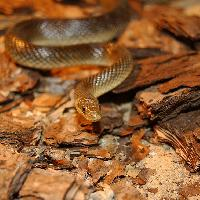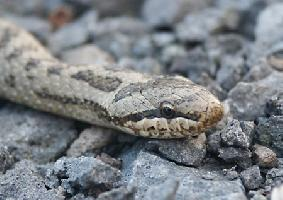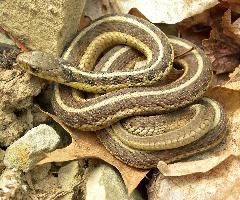
Poids et mesures
| Longueur | 1 m |
|---|
Description de l'animal
The European ratsnake, scientifically known as Elaphe situla, is a fascinating and unique reptile that inhabits various regions across Europe and parts of Asia. This species is particularly known for its striking appearance and its adaptability to different environments, making it a subject of interest among herpetologists and reptile enthusiasts alike.Elaphe situla can reach lengths of up to 1 meter (approximately 3 feet), though sizes can vary depending on the specific habitat and conditions. They have a slender, muscular body that is highly adapted for their lifestyle of hunting and burrowing. Their scales are smooth, providing a sleek appearance, and their coloration can vary significantly. Typically, they exhibit a base color of brown, gray, or yellow, overlaid with darker patches or saddles that can appear in a range of patterns. These patterns not only serve as camouflage within their natural environment but also make each individual snake distinct.
One of the most notable characteristics of the European ratsnake is its diet. As their name suggests, these snakes primarily feed on rodents, making them a natural form of pest control in their habitats. However, their diet is not limited to just rats and mice; they are known to consume other small mammals, birds, and occasionally eggs, demonstrating their opportunistic feeding behavior.
European ratsnakes are non-venomous, relying on constriction to subdue their prey. They are powerful constrictors, coiling their bodies around their prey and tightening their grip until the prey succumbs. Despite their formidable hunting skills, they are generally shy and reclusive animals, preferring to avoid confrontation with humans and larger predators.
The habitat of Elaphe situla spans a wide range, from the Mediterranean forests and scrublands to grasslands and agricultural fields. They are versatile in their habitat preferences but often reside in areas that offer ample cover and food sources. Their adaptability to different environments is one of the reasons they have managed to survive and thrive in various regions.
Reproduction in European ratsnakes involves oviparous (egg-laying) reproduction. Females lay clutches of eggs which they often deposit in hidden or protected locations such as under rocks, in decomposing vegetation, or within burrows. The eggs incubate for several weeks before hatching, with the young snakes emerging fully independent and capable of fending for themselves.
Despite their resilience and adaptability, Elaphe situla faces threats from habitat destruction, road mortality, and persecution due to human fear and misunderstanding. Conservation efforts are essential to ensure the survival of this species, focusing on habitat protection, education, and research to better understand their ecological role and requirements.
In summary, the European ratsnake is a remarkable reptile with a wide range of fascinating characteristics, from its distinctive appearance and dietary habits to its habitat preferences and reproductive behavior. As a key player in controlling rodent populations, it plays an essential role in the ecosystem, highlighting the importance of its conservation for maintaining biodiversity and ecological balance.
Animaux similaires
Nouvelles photos d'animaux
Top 10 des animaux
- Dolphin gull (Leucophaeus scoresbii)
- Diana monkey (Cercopithecus diana)
- Moustached guenon (Cercopithecus cephus)
- Galápagos tortoise (Geochelone nigra complex)
- Russian tortoise (Testudo horsfieldii)
- Stone loach (Barbatula barbatula)
- Japanese macaque (Macaca fuscata)
- Greek tortoise (Testudo graeca)
- Common flying dragon (Draco volans)
- Vendace (Coregonus albula)


